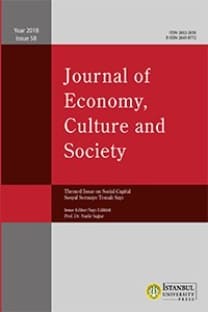GÖÇMEN OLMANIN ETNİK KİMLİK VE AİDİYET ALGISI ÜZERİNE ETKİSİ: AHISKA TÜRKLERİ ÖRNEĞİ
Etnik Kimlik, Göç, Aidiyet, Ahıska Türkleri
BEING IMMIGRANT AND THE UNDERSTANDING OF SENSE OF BELONGING AND ETHNIC IDENTITY: THE EXAMPLE OF AHISKA TURKS
Migration, Ahiska Turks, Ethnic identity, Sense of belonging,
___
- Adler, L. L., & Gielen, U. P. (Eds.) (2003). Migration: Immigration and emigration in international perspective. Westport, CT: Greenwood Publishing Group.
- Alba, R., & Nee, V. (1997). Rethinking assimilation theory for a new era of immigration. International Migration Review, 31(4), 826-874.
- Anik, M. (2012). Kimlik ve çokkültürlülük sosyolojisi. Istanbul: Acilim Kitap.
- Arnett, J. J. (2002). The psychology of globalization. American Psychologist, 57(10), 774- 783.
- Brickner, R. K. (Ed.) (2013). Migration, globalization, and the state. Basingstoke: Palgrave Macmillan. Guest, G., MacQueen, K., & Namey, E. (2012). Applied thematic analysis. Thousand Oaks, CA: Sage. Guvenc, B. (1999). İnsan ve kültür. İstanbul: Remzi Kitabevi.
- Hattatoglu, P., & Yakushko, O. (2014). Experiencing the formation of hybrid cultural identities in first- generation Turkish immigrants to the United States. Journal of Identity and Migration Studies, 8(1), 27-46.
- Ilgin, C., & Hacihasanoglu, O. (2006). Göç-aidiyet ilişkisinin belirlenmesi için model: Berlin / Kreuzberg örneği. İTÜ Dergisi/a, 5(2), 59-70.
- Kahani-Hopkins, V., & Hopkins, N. (2002). Representing british muslims: The strategic dimension to identity construction. Ethnic and Racial Studies, 25(2), 288-309.
- Kivisto, P. (2001). Theorizing transnational immigration: A critical review of current efforts. Ethnic and Racial Studies, 24(4), 549-577.
- Lichtman, M. (2014). Qualitative research for the social sciences. London: Sage. Martens, P., Dreher, A., & Gaston, N. (2010). Globalisation: The global village and the civil society. Futures, 42(6), 574-582.
- Martin, D. (1995). The choices of identity. Social Identities, 1(1), 5-20.
- Papastergiadis, N. (2010). Understanding hybrid identities: From mechanical models to complex system. World Futures, 66(3-4), 243-265.
- Pembecioglu, N. (2012). “Building identities: Living in the hybrid identities. Scientific Journal of Humanistic Studies, 4(7), 46-59.
- Portes, A., & Rumbaut, R. G. (2006). Immigrant America: A portrait. Berkeley: University of California Press. Rivas, C. (2012). Coding and analysing qualitative data. In C. Seale, (Ed.) Researching Society and Culture, (pp. 366-392). London: Sage.
- Ruhil A. A., & Daing Z. I. (2011). The contribution of language to the construction of self-identity among young Turkish Australian females.” UNITAR e-Journal 7(1), 27-38.
- Seale, C. (2012). Researching society and culture. London: Sage Publications.
- Schlesinger, P. (1987). On national identity: Some conception and misconceptions criticised. Social Science Information, 26(2), 219-264.
- ISSN: 2602-2656
- Yayın Aralığı: 2
- Başlangıç: 1960
- Yayıncı: İstanbul Üniversitesi Yayınevi
TÜRK SİNEMASINDA NAZİZM İDEOLOJİSİ: “KIRIMLI” FİLMİ VE GÖSTERGEBİLİMSEL ANALİZİ
Yaşar ZORLU, Caner ÇAKI, Mustafa KARACA
ÇAĞDAŞ YURTTAŞLIĞI KAVRAMAK: TEMEL YAKLAŞIMLAR, YENİ BOYUTLAR VE YENİ BİR YURTTAŞLIK ÇERÇEVESİ
TÜRKİYE’DE EMEĞİN KRİZİNİN BOYUTLARI
FİZİK ALANINDAKİ GELİŞMELERİN SOSYOLOJİYE YANSIMALARI: POZİTİVİZM
Birsen ŞAHİN KÜTÜK, Mehmet ŞAHİN
BALİ’DEKİ HİNDUİZM ÇERÇEVESİNDE SÜRDÜRÜLEBİLİRLİK ÜZERİNE DİNSEL ÖĞRETİLER
YÖNETİCİLERDE YÖNETİM ZİHNİYETİNİN EYLEME DÖNÜŞMESİ
Mehmet CANSIZ, M. Demet ULUSOY
GÖÇMEN OLMANIN ETNİK KİMLİK VE AİDİYET ALGISI ÜZERİNE ETKİSİ: AHISKA TÜRKLERİ ÖRNEĞİ
